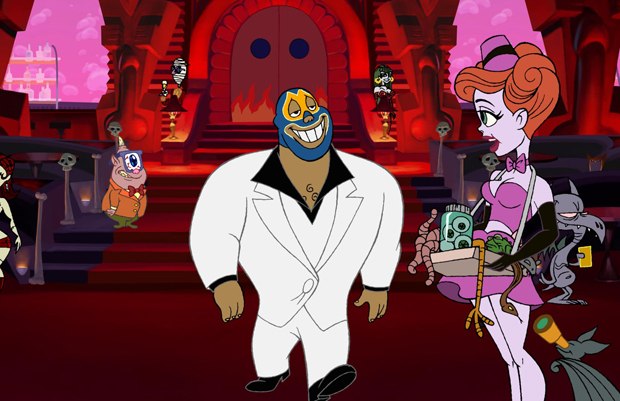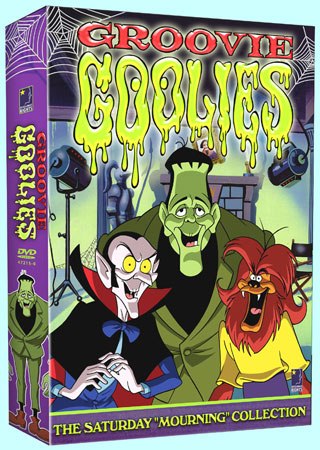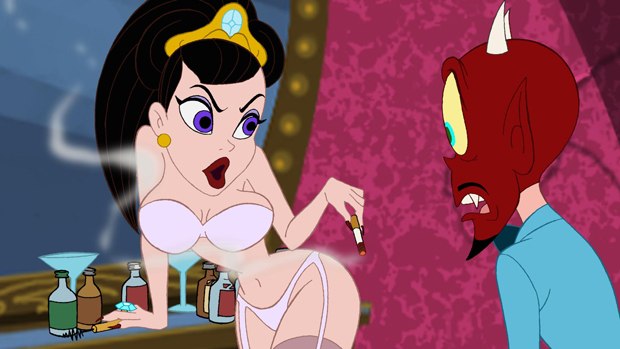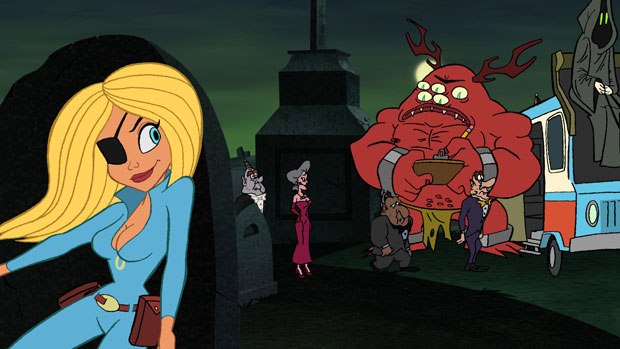Rick DeMott talks with producer Tom Klein about the challenges of creating the R-rated, 2D animated film, The Haunted World of El Superbeasto, directed by Rob Zombie.
R-rated 2D animation production in the United States is rare. But when Film Roman set out to produce animation on its own it acquired Rob Zombie's comic book The Haunted World of El Superbeasto to change that. Over the course of the five-year production Film Roman would become part of Starz and various execs and artists would be involved on the project. But nearly from the start, producer Tom Klein has been a part of the production.
Klein is an animation vet having worked on such productions as Mighty Mouse, the New Adventures, FernGully and currently The Simpsons. While Rob Zombie served as the director and was very hands on with the project, Klein supervised the crew while Zombie was off on other commitments.
And boy did they turn out an R-rated extravaganza. With lots of sex, violence and raunchy humor, this one's an original. To learn more about this outrageous show, I talked with Klein about his experiences.

Rick DeMott: Tell me about your involvement with El Superbeasto.
Tom Klein: When the project started life originally as a much smaller project, it was going to be a very low-budget direct-to-DVD. It was based on Rob [Zombie's] comic book and they had started developing the story down a path that Rob Zombie wasn't happy with, so they brought me on at a point in time when they had already started developing the story. I came on to create a plan that would allow the movie to be produced the way it exists now.
So it started with working with Rob Zombie to revise the script then assemble the crew to do the pre-production on it. I oversaw the casting with Rob Zombie, who had approval over everything, but I did all the casting, found all the voices and did the deals for the talent. I set up and oversaw all the voice sessions that we did.
We did this show on a [2D TV animation model], where we did the pre-production here at Film Roman and then we shipped our materials to Korea. Big Star Animation did the animation in Korea and then they ship that back and we do post-production here. So I found Big Star and went over there and worked with them to create the animation.
I supervised the crew for the run of the show. Rob Zombie, during the course of the production, was a busy guy and did quite a few different things. He was off on tour several times and had a new CD come out and several movies come out. I believe Halloween went into production and was completed during the course of our production. So while he was away, I'd direct the crew, following Rob's direction. Sort of the beyond the floor part of it -- getting the scenes working and making things correct to be sent to Korea. And as I said, I went to Korea and directed that studio and then came back and oversaw all the post-production. I found mixers and sound supervisors. Hired the art director early on.
I managed the project at Film Roman pretty much all the way through. I got us more money when we needed more money, and took it all the way to delivery.
RD: How was the collaborative process with Rob Zombie?
TK: It was amazing. He's a brilliant guy. He knew exactly what he was looking for. It was based on his comic book, so he knew the story he was after, but he was wide open to expanding and opening up concepts that were only a bit in the comic book and turn them into material that would work really well with animation. He understands animation. He's a big fan of animation.
So the collaboration was very intense. He was very detail oriented, very hands on. A lot of time we had to communicate long distance because of his traveling, but he looked at every detail of things and was wide open to great ideas from the animators. As is typical with animation, a lot of work is done in the storyboard stage to get a scene to work correctly or a sequence to work correctly. He was very collaborative in working with a wide range of artists. Because of the way the project happened, we had a few different crews over a few different periods of time working on different aspects of it. He was in the studio a tremendous amount of the time, approving artworks and approving scenes, giving direction on how the artwork should be different. Anything from the storyboards to the animation to the art direction. When we got into post-production, he was living here in the edit room with the rest of us, doing all the directorial things that happen.
RD: Were there any specific influences that he brought to the project?
TK: The comic book. There's been a line quoted around the press that it's sort of a combination between The Munsters and A Hard Days Night. But I'd say his influences were animation overall. He was a particular fan of Groovie Goolies. He liked how humor works in animation.
For the music, we tried a few different approaches in the early stages. We were trying for more of a dramatic feel to some of the scenes, so he had the idea of bringing in Hard 'N Phirm to do the songs that are there now.
We looked at a lot of different movies for different ideas. He is a big fan of The Simpsons and Family Guy on TV now.
He was really eager to make a movie that was first and foremost funny. He loved the cartoony style we were able to bring to it. There was a lot of people that contributed to the look and the timing of the show.
RD: I got a strong Ren & Stimpy vibe to it. Did that come from the animators?
TK:
There were a bunch of people who brought that. There were quite a few people who worked on the movie that worked on Ren & Stimpy. Myself I worked with John Kricfalusi on the Mighty Mouse Show. I produced that years back. It had a lot of the same style. Same with the "Harlem Shuffle" music video for the Rolling Stones that John did. I produce that as well. It's sort of the same family of styles that I worked on with John and Ralph Bakshi before.
There's a group of artists that did the boards and designed a lot of the characters that came from that world. And the timing also brings in some of the Ren & Stimpy performance style that you see in there.
RD: How was it working with the voice cast?
TK: Amazing. As typical as it is with animation, very few of the cast were in the same place at the same time. The first person cast was Paul Giamatti as Dr. Satan. We went to New York to record him. Did all his work in a day. He was really into the project. Loves Rob. Loved the idea of doing a crazy animated project. He's done animation before, but he loved the idea that it was so off-the-wall and so outrageous and R-rated. He got into it right off the bat. He had a script, but he ad-libbed quite a bit. He brought an amazing performance. He really, really enjoyed it. He was a real pleasure to work with.
A similar thing happened with some of the other casting. Except for Tom Papa who came in -- he was the co-writer of the movie as well -- we did several sessions with him, but nearly everyone else, including Sheri Moon Zombie and Rosario Dawson, did their work in a day and were really into doing this kind of outrageous material.
Rob was very eager to have a very eclectic cast so we went out to his stable of actors that he's worked with on various projects and brought them in.
RD: Was there any executive hesitation to any of the material? Was there something that was too outrageous and had to be left out?
TK: From the beginning everyone understood at the company that the idea was to make an R-rated cult classic, midnight movie type of movie. One of the initial executives Jerry Davis saw the potential for that midnight movie feel.
And then at the earliest stages, from the script, it was real clear that we couldn't do the material without going to an R rating, and it was decided early on that we would make the movie as Rob wanted it and worry about the ratings after.
There is a rumor going around that there is an unrated version of the movie, but that's not true. The cut that has been released for these midnight shows and will be out on DVD is Rob's cut, his director's cut that we submitted to the MPAA for approval and they gave us an R rating with no changes requested. And that had always been the intent to create the movie knowing that it was outrageous and pushing envelopes and that it would fit Rob's vision of what he was after. We knew we were after an R rating.
One of the things that was difficult about the production was that our company changed hands during the production. Over the five years that it took to make the movie there was quite a bit of changes in the executive ranks and various executives that would come in had different issues with this, that or the other about it, but no one every wavered from the commitment to making an R-rated movie. They understood that was inherent in the material. But there were a variety of reactions. Some people liked it more than others. There were notes sometimes that said could you tone this down or that down, but Rob didn't do it, he said, "I want to do it this way," and to their credit they didn't turn around and say you can't. So it never turned into anything difficult.
RD: What was one of the biggest challenges on the production?
TK: There were many. The hardest one was keeping the project moving forward over the five-year plan.
The immediate challenge was getting Rob reengaged. Because of the path they went down with the original storyboards that he was very unhappy with it, there was point in time that he may not have continued with it. So the first big challenge was to convince Rob that we could make the kind of movie that he wanted to see. Once we got him fully engaged, he led the way though to the end even with all these diversions happening.
The second big challenge was getting the money we needed to make the movie right. Like I said, there were changes in the executive ranks over the years, so that was my challenge to get the money we needed to make the quality movie that the material demanded.
The third was trying to keep the creative aspects of the movie unified over such a long period of time with so many different artists working on it, and create a cohesive whole with the art direction and design style, the look of the movie and the tone of the movie.
RD:What was the most enjoyable part?
TK: Working with Rob. He's such a strong filmmaker. He knows what he's looking for. He has tons of ideas. He really had a vision for this to be the type of movie that it ended up being -- the crazy, over-the-top, R-rated comedy in 2D animation.
And the second was working with the whole crew from the beginning to the end. We were lucky to get a tremendous group of artists that we were able to use in various ways on the show to really bring out their strengths. By the time we were in the home stretch, we had an amazing crew, which was very small by anyone's standards, six or seven people. [At that time] we completely re-wrote the opening and changed the ending tremendously, and did all that with a really tight crew that worked really well with Rob.
RD: What potential do you see for more adult content like this coming out in the U.S.?
TK: From the days working with Ralph [Bakshi on Mighty Mouse], I've been trying to get an R-rated animated movie out there. There's been a lot of effort, not just by me, but a lot of people, but it's been difficult, so I hope this movie can excite an audience and the powers that be can see the value to appealing to different markets. The way I've always looked it is -- the kids that grew up with Ren & Stimpy and Beavis & Butt-head and Simpsons and the outrageous [2D] animation for its day they're all old enough to watch older material and they're the same ones that watch all the R-rated comedies that come out of Hollywood regularly. So I think there is a huge potential to appeal to the R-rated comedy audience that's very large with animated projects if the stories and the design and the content is interesting for them.
Rick DeMott is the director of content for Animation World Network, VFXWorld and AWNtv. Additionally, he's the creator of the movie review site, Rick's Flicks Picks, which was recently named one of the 100 best movie blogs by The Daily Reviewer. He has written for TV series, such as Discovery Kids' Growing Up Creepie and Cartoon Network's Pet Alien, the animation history book Animation Art, and the humor, absurdist and surrealist website Unloosen. Previously, he held various production and management positions in the entertainment industry.











